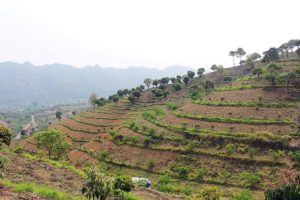
Government officers from the mountainous countries of Bhutan and Nepal have visited highly successful agroforestry sites in Northwest Vietnam that are helping to restore degraded sloping land and improve farmers’ incomes.
The steep upland farming areas of Bhutan, Nepal and Vietnam share similar challenges in establishing sustainable agricultural practices that improve livelihoods and the environment.
To share knowledge and experience from working with farmers in the steeply sloping landscapes of Northwest Vietnam, government officers from Bhutan and Nepal traveled to Son La and Dien Bien provinces to explore an array of well-developed agroforestry systems, demonstration sites, plantations and nurseries. The visitors learned how the various systems have contributed to increased food security, income stability, water availability and reduced soil erosion.
As well as designing and establishing the systems with farmers and government extension officers, the World Agroforestry Centre (ICRAF), as part of the CGIAR Research Program on Forests, Trees and Agroforestry (FTA), has been working with farmers to monitor changes in soil erosion following the adoption of agroforestry practices.
Chuki Wangmo and Kinley Wangmo from the Institute of Conservation and Environmental Research of the Bhutan Ministry of Agriculture and Forests, and Ram Babu Paudyal and Bishnu Kumari Adhikari from Nepal’s Ministry of Forestry and Soil Conservation, noted that cultivating on a steep gradient is something that communities across all three countries were familiar with. However, the associated issues of soil and wind erosion were not easy to mitigate.

The visitors were first shown a five-year-old complex agroforestry system in Son La, where the recorded decline in soil erosion since the introduction of agroforestry was of particular relevance to the officers from Bhutan, who work with farmers in mountainous terrain.
“Hard evidence is very important,” noted Chuki Wangmo. “If people at both the national and local levels can see how agroforestry can be of benefit to crop production, especially by addressing soil and wind erosion issues which many farmers suffer from, it would encourage wider adoption of agroforestry in our country.”
Farmers in both Vietnam and Bhutan are already significantly affected by the impacts of a rapidly changing climate. In Bhutan, changes to precipitation are exacerbating the rate of soil erosion, which is speeding a decline in soil fertility, compounded by the steep terrain. The government often has to compensate farmers affected by crop losses and damage caused by landslides and flooding.
About 70 percent of Bhutanese farmers rely on agriculture, forestry and livestock for subsistence livelihoods yet only 8 percent of Bhutan’s total land area is cultivable. The establishment of agroforestry would enable farmers cultivating small areas of land to improve the efficiency and diversity of crop production in already fragile mountainous areas, whilst meeting the socioeconomic needs of the community.
“The successful agroforestry demonstration sites we visited revealed how agroforestry systems can increase land-use efficiency for smallholders by increasing the productivity per area unit,” noted Ram Babu Paudyal.
Nepal could reap the benefits of such simple yet effective agroforestry systems to produce a diverse range of products on small areas of land.
In Son La province, the Nepali visitors heard how farmers involved in a 50-hectare demonstration agroforestry landscape had migrated from a neighboring area affected by the construction of a hydropower dam.
The role of agroforestry in improving livelihoods is particularly relevant to Nepal because it is experiencing increased out-migration from rural areas. This was a key motive of the Food and Agriculture Organization of the United Nations in funding a pilot study dubbed Enhancing Rural Livelihoods in Abandoned/Underutilized Agricultural Land through Agroforestry.
“We hope that agroforestry will encourage the return of urban migrants to farms,” said Ram Babu Paudyal. “If agroforestry can be demonstrated as a land-use system that can provide sustainable sources of income and sustainable land cultivation, it could help address poverty and many national environmental concerns.”
ICRAF Vietnam recognizes the importance of establishing long-term relationships and collaboration with district and community organizations to enable the sustainable implementation of agroforestry. Agricultural and forestry extensionists or rural advisors are a key component of such relations. The visitors had the chance to speak with extensionists at the field sites to better understand their role as communicators of technical advice and guidance to, and between, farmers.
“Extensionists are clearly very valuable when it comes to building cohesion between the agricultural and forestry sectors,” commented Kinley Wangmo. “We learned that there were many different stakeholders, including experts, involved in the process of enabling agroforestry on the ground. Our visit to the field sites showed that agroforestry systems differ depending on the type of landscape and that the needs of farmers in those landscapes must always be prioritized.”
By Anoushka Carter, originally published at ICRAF’s Agroforestry World.
This work is part of the CGIAR Research Program on Forests, Trees and Agroforestry, which is supported by CGIAR Fund Donors.











